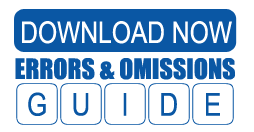McGowanPRO
What are insurance underwriters looking for in an investment advisor’s application for errors & omissions (aka professional liability) insurance?
Download the comprehensive 33-page Guide to gain:
– Clarity to the Insurance Evaluation Process
– Specific Guidance and Roadmap to Improved Outcomes
– Risk Management Resources for your Practice
Assets Under Management (AUM)
Part 6: The Investment Advisors Guide to Errors & Omissions Insurance
 By Gary Sutherland, CIC, MLIS
By Gary Sutherland, CIC, MLIS
In all professional liability applications for investment professionals there are questions asking about assets under management (AUM). Generally AUM is broken down by the following classifications:
– Discretionary
– Non-Discretionary
– ERISA
– Non ERISA
AUM is also classified by size:
$1mm to $350mm in AUM – Small
$350mm to $1b in AUM – Mid-size
$1b and up AUM – Large
Most carriers define their individual appetite based on these classifications (size of firm) and AUM type. Insurance companies will often have different underwriters handle different classes of business based on AUM; this is important to understand as it directly impacts premiums.
Many of the standard errors & omissions programs have AUM cutoffs at $1B, forcing an applicant with higher AUM into an institutional category where premiums can be double, or sometimes even triple the cost.
Similar challenges occur when a seasoned advisor starts up firm with relatively low AUM, but it grows quickly and will soon require an institutional level policy where there may be more investment flexibility and fewer exclusions. The disparity between their AUM and their sophistication level becomes a challenge given the minimum AUM requirements of the institutional divisions.
ERISA AUM tends to be handled differently; most insurance carriers will want to know if the applicant is bonded as may be required by ERISA’s section 412. In addition, you will need to ensure you have coverage as a fiduciary, and that such coverage is clearly included in the definition of professional services or added by endorsement. ERISA exclusions are common along with exclusions for your status as a fiduciary. The ERISA/fiduciary space is an area of growing claims and cannot be overlooked.
Due to the complexity of ERISA law and potential lawsuits, underwriters often want details on your staff’s experience dealing with ERISA clients. If possible, disclose in your application the name of your ERISA attorney and/or any outside compliance consultants. Several insurance companies will provide premium discounts for applicants who utilize these outside services, understanding that their presence makes your firm a better risk. If you have internal compliance support, be sure to inform the underwriter.
One common application mistake is when the applicant lists the total value of a large client’s AUM rather than the portion they advise on. This can become clear when revenue is much lower than the reported AUM would support. Underwriters use a guide of 1% for calculating revenues based on AUM, and if your percentage is well outside of this parameter, you should provide an explanation.
Large percentage increases or decreases in AUM from year to year will also cause additional questions. Provide the underwriter reasons behind any significant changes in the AUM.
Conclusion
Review your AUM prior to submission to confirm the accuracy of classifications, and any potential discrepancies from previous years.
1. Accurately classify your AUM by only listing the actual AUM of larger clients that you handle.
2. Accurately classify AUM between discretionary, non-discretionary, ERISA, and non-ERISA.
3. As previously stated, proactively explain any discrepancies in revenue to AUM, especially if revenue is significantly higher or lower than 1% of AUM.
Back to Series Main Page
Contact us for additional information:
Gary Sutherland, MLIS, CIC Garys@mcgowanprofessional.com 508-656-1350

